
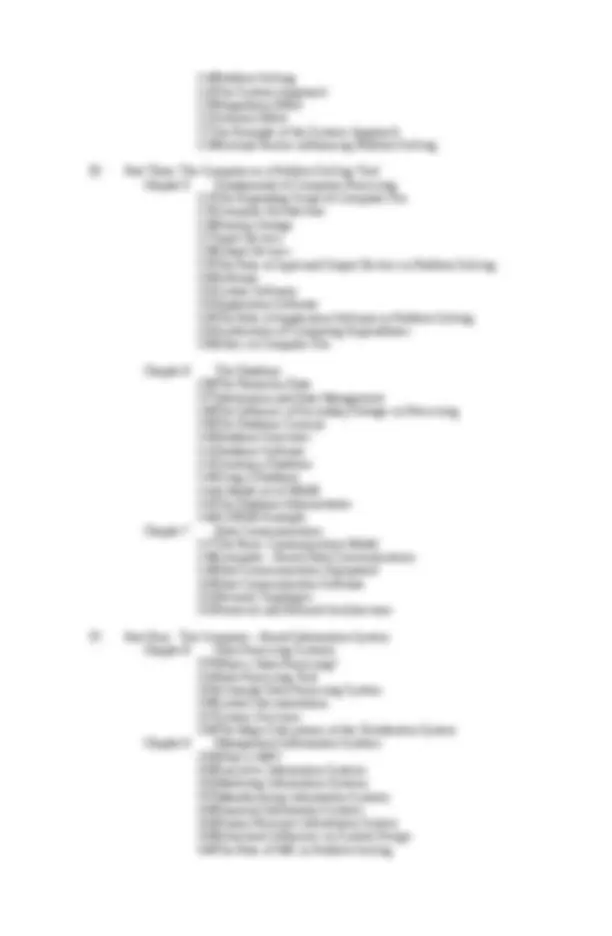
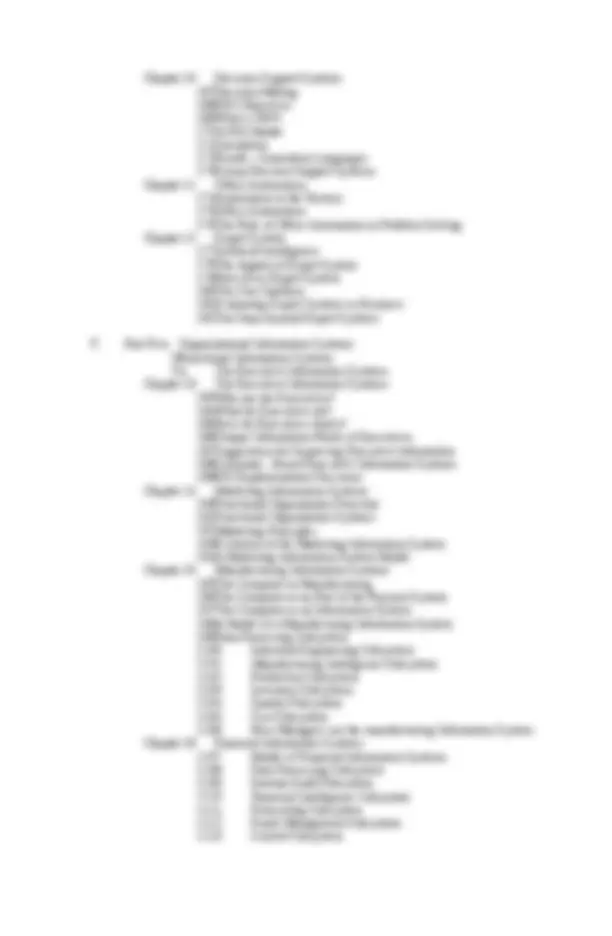
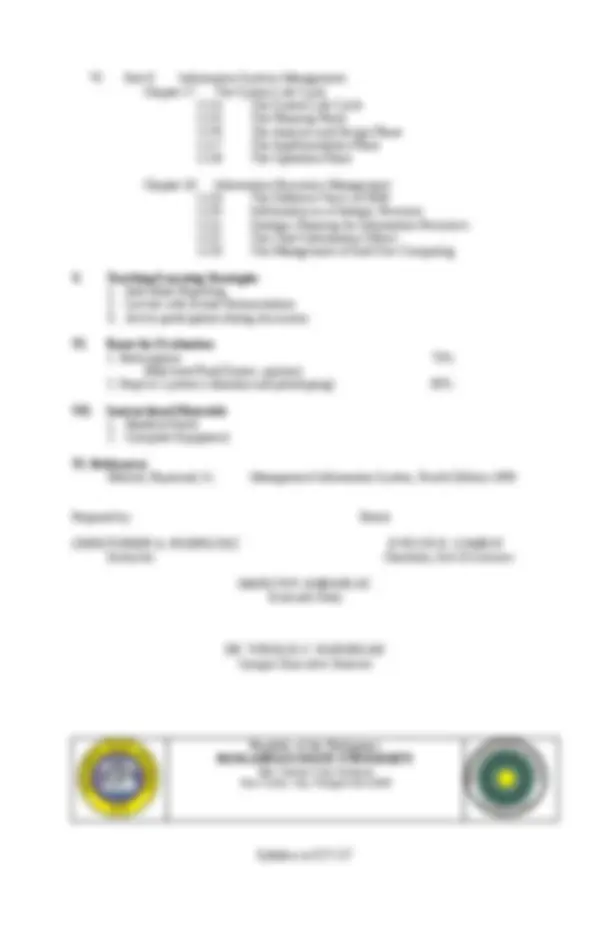
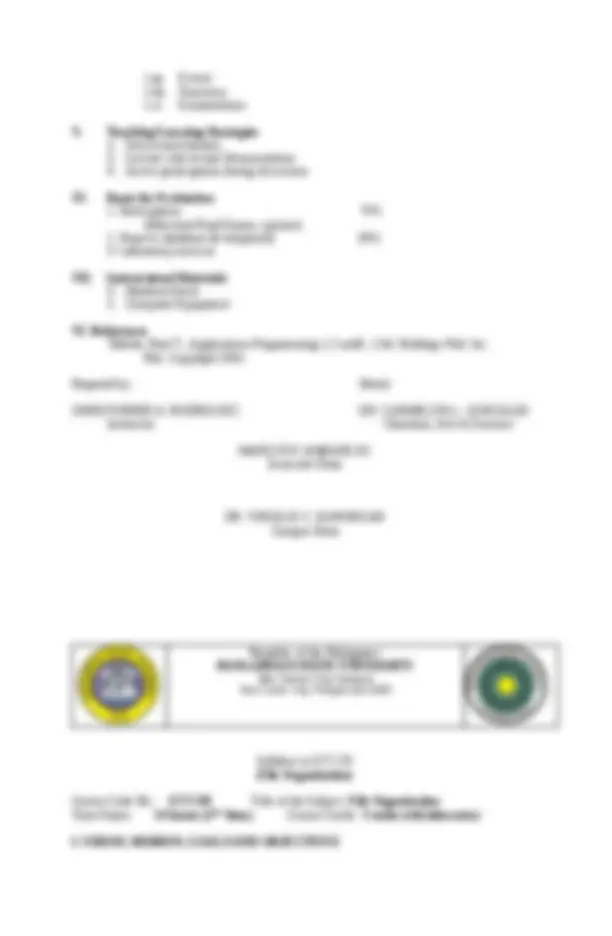
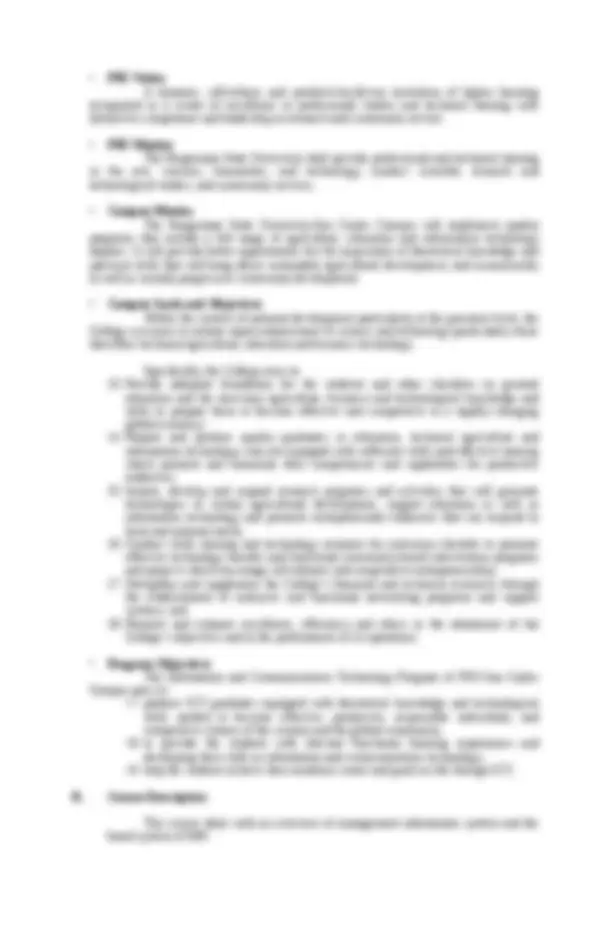
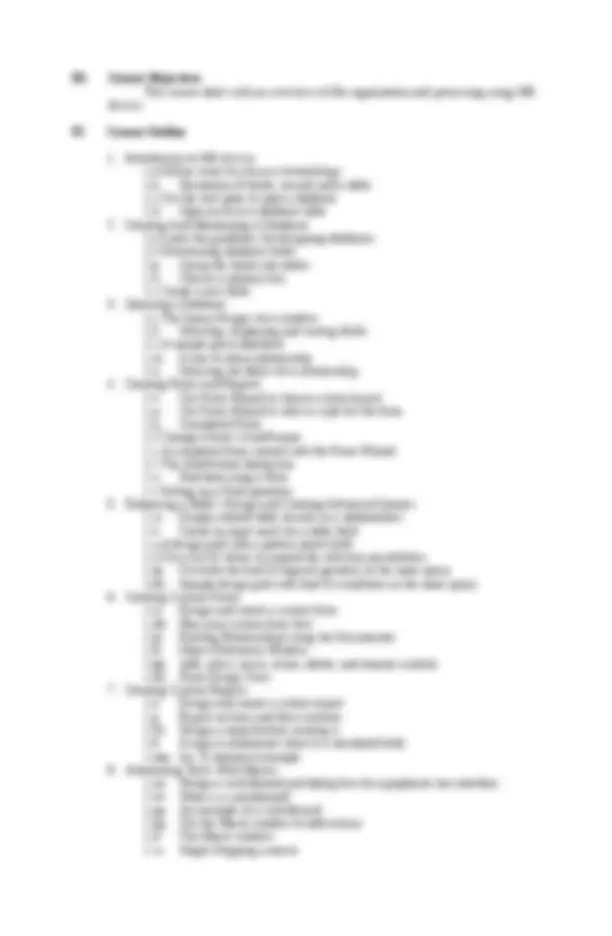
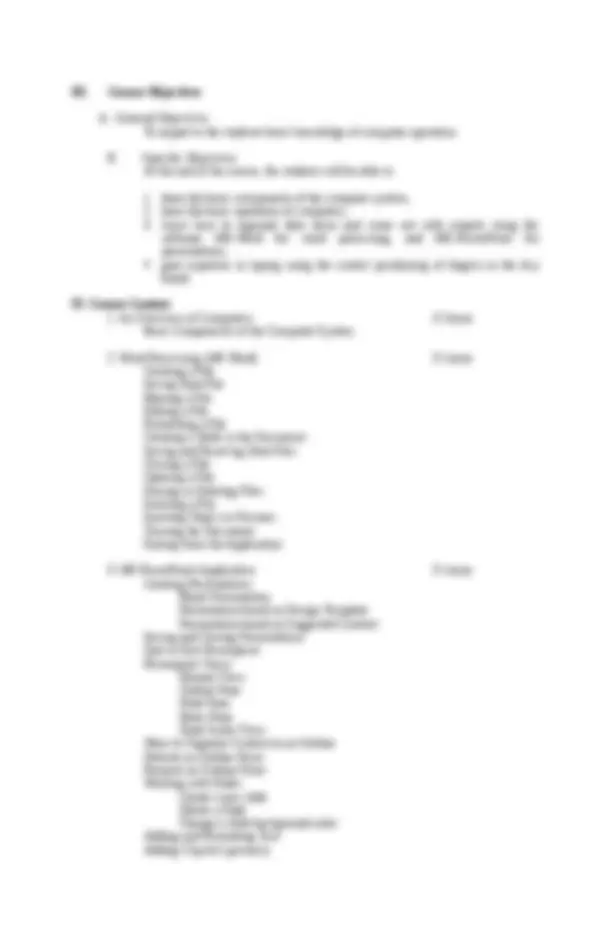
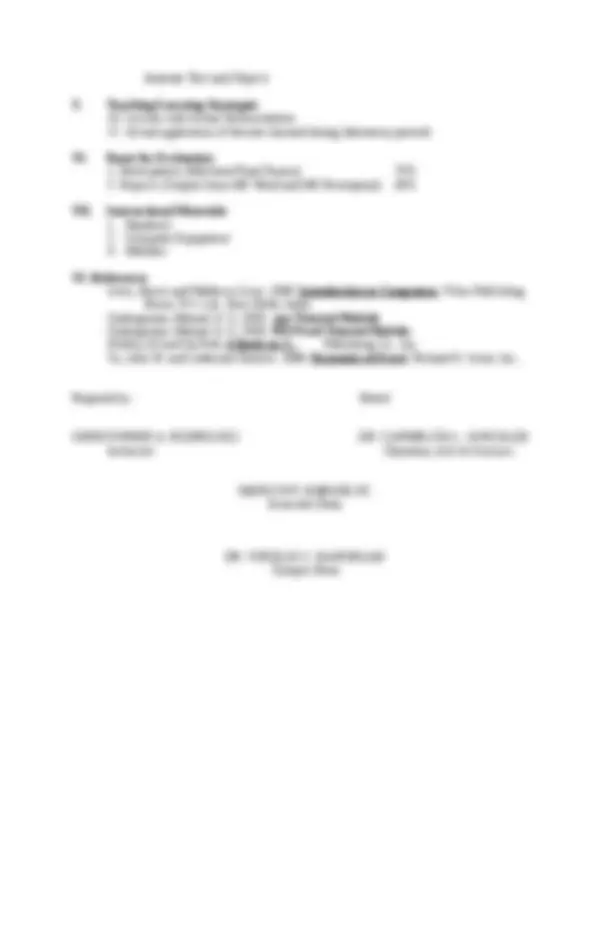


Study with the several resources on Docsity

Earn points by helping other students or get them with a premium plan


Prepare for your exams
Study with the several resources on Docsity

Earn points to download
Earn points by helping other students or get them with a premium plan
Community
Ask the community for help and clear up your study doubts
Discover the best universities in your country according to Docsity users
Free resources
Download our free guides on studying techniques, anxiety management strategies, and thesis advice from Docsity tutors
syllabus in MIS
Typology: Study notes
1 / 14

This page cannot be seen from the preview
Don't miss anything!









Republic of the Philippines PANGASINAN STATE UNIVERSITY San Carlos City Campus San Carlos City, Pangasinan 2420
Syllabus in HRDM ELECT 101 (Management Information System)
Course Code No.: HRDM ELECT 101 Title of the Subject: Management Information System
Time Frame: 54 hours (2nd^ Sem.)^ Course Credit:^ 3 units
I. VISION, MISSION, GOALS AND OBJECTIVES
Specifically, the College aims to:
The Information and Communications Technology Program of PSU-San Carlos Campus aims to: •.1. produce ICT graduates equipped with theoretical knowledge and technological skills needed to become effective, productive, responsible individuals, and competitive citizens of the country and the global community; •.2. to provide the students with relevant functional learning experiences and developing their skills in information and communications technology; •.3. help the students achieve their academic career and goals in life through ICT;
II. Course Description
This course deals with an overview of management information system and the broad system of MIS.
III. Course Objectives
A. General Objectives: To impart to the students the basic knowledge about how computers came about, computer components, uses of computers and career opportunities in computers
B. Specific Objectives: At the end of the course, the students are expected to: B.1. know the significance of information management, B.2. understand the basic fundamental principles of MIS, B.3. know the computer as problem solving tool using MIS B.4. know the computer-based as information system and database management
IV. Course Outline
I. Part One. Information Management Chapter 1 Introduction to Information Management I.1. Importance of Information Management I.2. The Modern Manager I.3. Management Skills I.4. The Manager and System I.5. The Information Services Organization I.6. The Need for a Complete of Information System I.7. The Computer as an Element in an Information System
II. Part Two. Fundamental Principles Chapter 2 Theory of Management and Organizations I.8. Theory I.9. Management Theory II.a. Importance of Management Theory to Information Management I.10.Organization Theory I.11.Importance of Organization Theory to Information Management I.12.System Theory I.13.System Theory of Management and Organization Chapter 3 The General System Model of the Firm I.14.Models I.15.The General System Model I.16.Use of the General System Model I.17.The Emerging Emphasis on Resource Flows in Organization Chapter 4 The System Approach
Chapter 10 Decision Support Systems I.67.Decision Making I.68.DSS Objectives I.69.What is DSS? I.70.A DSS Model I.71.Simulation I.72.Fourth – Generation Languages I.73.Group Decision Support Systems Chapter 11 Office Automation I.74.Automation in the Factory I.75.Office Automation I.76.The Role of Office Automation in Problem Solving Chapter 12 Expert System I.77.Artificial Intelligence I.78.The Appeal of Expert System I.79.Parts of an Expert System I.80.The User Interface I.81.Evaluating Expert Systems in Business I.82.The Steps beyond Expert Systems
V. Part Five Organizational Information Systems V.i.Functional Information Systems V.ii. The Executive Information Systems Chapter 13 The Executive Information Systems I.83.Who are the Executives? I.84.What do Executives do? I.85.How do Executives thinks? I.86.Unique Information Needs of Executives I.87.Suggestions for Improving Executive Information I.88.Computer - Based Executive Information Systems I.89.EIS Implementation Decisions Chapter 14 Marketing Information Systems I.90.Functional Organization Structure I.91.Functional Organization Systems I.92.Marketing Principles I.93.Evolution of the Marketing Information System I.94.A Marketing Information System Model Chapter 15 Manufacturing Information Systems I.95.The Computer in Manufacturing I.96.The Computer as an Part of the Physical System I.97.The Computer as an Information System I.98.A Model of a Manufacturing Information System I.99.Data Processing Subsystem I.100. Industrial Engineering Subsystem I.101. (^) Manufacturing Intelligence Subsystem I.102. Production Subsystem I.103. Inventory Subsystem I.104. Quality Subsystem I.105. Cost Subsystem I.106. How Managers use the manufacturing Information System Chapter 16 Financial Information Systems I.107. Model of Financial Information Systems I.108. Data Processing Subsystem I.109. Internal Audit Subsystem I.110. (^) Financial Intelligence Subsystem I.111. Forecasting Subsystem I.112. Funds Management Subsystem I.113. Control Subsystem
VI. Part 6 Information Systems Management Chapter 17 The System Life Cycle I.114. The System Life Cycle I.115. The Planning Phase I.116. (^) The Analysis and Design Phase I.117. The Implementation Phase I.118. The Operation Phase
Chapter 18 Information Resources Management I.119. The Different Views of IRM I.120. Information as a Strategic Resource I.121. Strategic Planning for Information Resources I.122. The Chief Information Officer I.123. The Management of End-User Computing
V. Teaching/Learning Strategies
VI. Bases for Evaluation
VII. Instructional Materials
VI. References Mcleod, Raymond, Jr., Management Information System, Fourth Edition 1993
Prepared by: Noted:
Instructor Chairman, Arts & Sciences
Associate Dean
Campus Executive Director
Republic of the Philippines PANGASINAN STATE UNIVERSITY San Carlos City Campus San Carlos City, Pangasinan 2420
Syllabus in ICT 127
•.5. to provide the students with relevant functional learning experiences and developing their skills in information and communications technology; •.6. help the students achieve their academic career and goals in life through ICT;
II. Course Description This course deals with an overview of database design and implementation using MS-Access.
III. Course Objectives
C. General Objectives: To impart to the students the basic knowledge about how computers came about, computer components, uses of computers and career opportunities in computers
D. Specific Objectives: At the end of the course, the students are expected to: B.5. Know the purpose of database systems, B.6. Create database design B.7. Understand data definition language B.8. Understand Database Administrator B.9. Start MS-Access B.10. Create table B.11. simple database program
IV. Course Outline
1.aa. Events 1.bb. Functions 1.cc. Enumerations
V. Teaching/Learning Strategies
VI. Bases for Evaluation
VII. Instructional Materials
VI. References Tañedo, Roel T., Applications Programming 1,2 and3., CAL Holdings Phil. Inc. Phil. Copyright 2004
Prepared by: Noted:
Instructor Chairman, Arts & Sciences
Associate Dean
Campus Dean
Republic of the Philippines PANGASINAN STATE UNIVERSITY San Carlos City Campus San Carlos City, Pangasinan 2420
Syllabus in ICT 120 ( File Organization )
Course Code No.: ICT 120 Title of the Subject: File Organization Time Frame: 54 hours (2nd^ Sem.)^ Course Credit:^ 3 units with laboratory
I. VISION, MISSION, GOALS AND OBJECTIVES
III. Course Objectives
This course deals with an overview of file organization and processing using MS- Access.
IV. Course Outline
V. Teaching/Learning Strategies
VI. Bases for Evaluation
VII. Instructional Materials
VI. Reference
Tañedo, Roel T., Applications Programming 1,2 and3., CAL Holdings Phil. Inc. Phil. Copyright 2004
Prepared by: Noted:
Instructor Chairman, Arts & Sciences
Associate Dean
Campus Dean Republic of the Philippines PANGASINAN STATE UNIVERSITY San Carlos City Campus San Carlos City, Pangasinan 2420
Syllabus in ICT 115 (Management Information System)
Course Code No.: ICT 115 Title of the Subject: Int. Application Software and
Productivity Tool Time Frame: 54 hours (2nd^ Sem.) Course Credit: 3 units with laboratory
A. PSU Vision
III. Course Objectives
A. General Objectives To impart to the students basic knowledge of computer operation
B. Specific Objectives At the end of the course, the students will be able to:
IV. Course Content
Animate Text and Objects
V. Teaching/Learning Strategies
VI. Bases for Evaluation
VII. Instructional Materials
VI. References Leon, Alexis and Mathews Leon. 1999. Introduction to Computers. Vikas Publishing House Pvt. Ltd., New Delhi, India. Cadongonan, Manuel Jr. G. 2003. ppt Tutorial Module. Cadongonan, Manuel Jr. G. 2003. MS Word Tutorial Module. Kellely, Al and Ira Pohl. A Book on C., Publishing Co., Inc. Yu, John W. and Catherine Demers. 1989. Dynamics of Excel. Richard D. Irwin, Inc.,
Prepared by: Noted:
Instructor Chairman, Arts & Sciences
Associate Dean
Campus Dean